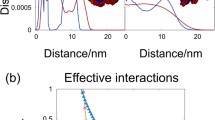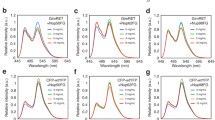Abstract
The crowding of macromolecules in the cell nucleus, where their concentration is in the range of 100 mg/ml, is predicted to result in strong entropic forces between them. Here the effects of crowding on polynucleosome chains in vitro were studied to evaluate if these forces could contribute to the packing of chromatin in the nucleus in vivo. Soluble polynucleosomes ∼20 nucleosomes in length formed fast-sedimenting complexes in the presence of inert, volume-occupying agents poly(ethylene glycol) (PEG) or dextran. This self-association was reversible and consistent with the effect of macromolecular crowding. In the presence of these crowding agents, polynucleosomes formed large assemblies as seen by fluorescence microscopy after labelling DNA with the fluorescent stain DAPI, and formed rods and sheets at a higher concentration of crowding agent. Self-association caused by crowding does not require exogenous cations. Single, ∼800 nucleosome-long chains prepared in 100 μM Hepes buffer with no added cations, labelled with the fluorescent DNA stain YOYO-1, and spread on a polylysine-coated surface formed compact 3-D clusters in the presence of PEG or dextran. This reversible packing of polynucleosome chains by crowding may help to understand their compact conformations in the nucleus. These results, together with the known collapse of linear polymers in crowded milieux, suggest that entropic forces due to crowding, which have not been considered previously, may be an important factor in the packing of nucleosome chains in the nucleus.



Similar content being viewed by others
References
Adams M, Fraden S (1998) Phase behavior of mixtures of rods (tobacco mosaic virus) and spheres (polyethylene oxide, bovine serum albumin). Biophys J 74:669–677
Albiez H, Cremer M, Tiberi C, Vecchio L, Schermelleh L, Dittrich S, Küpper K, Joffe B, Thormeyer T, von Hase J, Yang S, Rohr K, Leonhardt H, Solovei I, Cremer C, Fakan S, Cremer T (2006) Chromatin domains and the interchromatin compartment form structurally defined and functionally interacting nuclear networks. Chromosome Res 14:707–733
Asakura S, Oosawa F (1954) On interaction between two bodies immersed in a solution of macromolecules. J Chem Phys 22:1255–1256
Belmont AS, Bruce K (1994) Visualization of G1 chromosomes: a folded, twisted, and supercoiled chromonema model of interphase chromatid structure. J Cell Biol 127:287–302
Bohrmann B, Haider M, Kellenberger E (1993) Concentration evaluation of chromatin in unstained resin-embedded sections by means of low-dose ratio-contrast imaging in STEM. Ultramicroscopy 49:235–251
Buitenhuis J, Donselaar LN, Buining PA, Stroobants A, Lekkerkerker HNK (1995) Phase separation of mixtures of colloidal boehmite rods and flexible polymer. J Colloid Interface Sci 175:46–56
Cano S, Caravaca JM, Martin M, Daban JR (2006) Highly compact folding of chromatin induced by cellular cation concentrations. Evidence from atomic force microscopy studies in aqueous solution. Eur Biophys J 35:495–501
Cooke IR, Williams DRM (2004) Collapse of flexible–semiflexible copolymers in selective solvents: single chain rods, cages, and networks. Macromolecules 37:5778–5783
Cunha S, Woldringh CL, Odijk T (2001) Polymer-mediated compaction and internal dynamics of isolated Escherichia coli nucleoids. J Struct Biol 136:53–66
Dobrynin AV, Colby RH, Rubinstein M (2005) Polyelectrolytes in solutions and at surfaces. Prog Polym Sci 30:1049–1118
Garrard WT, Nobis P, Hancock R (1977) Histone H3 disulfide reactions in interphase, mitotic, and native chromatin. J Biol Chem 252:4962–4967
Giannasca PJ, Horowitz RA, Woodcock CL (1993) Transitions between in situ and isolated chromatin. J Cell Sci 105:551–561
Hancock R (2004) A role for macromolecular crowding effects in the assembly and function of compartments in the nucleus. J Struct Biol 146:281–290
Hancock R (2007) Packing of the polynucleosome chain in interphase chromosomes: evidence for a contribution of macromolecular crowding. Semin Cell Dev Biol 18:668–675
Hansen JC (2002) Conformational dynamics of the chromatin fiber in solution: determinants, mechanisms, and functions. Annu Rev Biophys Biomol Struct 31:361–392
Horowitz RA, Agard DA, Sedat JW, Woodcock CL (1994) The three-dimensional architecture of chromatin in situ: electron tomography reveals fibers composed of a continuously variable zig-zag nucleosomal ribbon. J Cell Biol 125:1–10
Hosek M, Tang JX (2004) Polymer-induced bundling of F-actin and the depletion force. Phys Rev E 69:051907
Jackson DA, Yuan J, Cook PR (1988) A gentle method for preparing cyto- and nucleoskeletons and associated chromatin. J Cell Sci 90:365–378
Kojima M, Kubo K, Yoshikawa K (2006) Elongation/compaction of giant DNA caused by depletion interaction with a flexible polymer. J Chem Phys 124:024902
Lebofsky R, Bensimon A (2003) Single DNA molecule analysis: applications of molecular combing. Brief Funct Genomic Proteomic 1:385–936
Leforestier A, Livolant F (1997) Liquid crystalline ordering of nucleosome core particles under macromolecular crowding conditions: evidence for a discotic columnar hexagonal phase. Biophys J 73:1771–1776
Leuba SH, Yang G, Robert C, Samori B, van Holde K, Zlatanova J, Bustamante C (1994) Three-dimensional structure of extended chromatin fibers as revealed by tapping-mode scanning force microscopy. Proc Natl Acad Sci USA 91:11621–11625
Marenduzzo D, Micheletti C, Cook PR (2006) Entropy-driven genome organization. Biophys J 90:3712–3721
Murphy LD, Zimmerman SB (1995) Condensation and cohesion of lambda DNA in cell extracts and other media: implications for the structure and function of DNA in prokaryotes. Biophys Chem 57:71–92
Naora H, Naora H, MirskyAE, Allfrey VG (1961) Magnesium and calcium in isolated cell nuclei. J Gen Physiol 44:713–742
Richter K, Nessling M, Lichter P (2007) Experimental evidence for the influence of molecular crowding on nuclear architecture. J Cell Sci 120:1673–1680
Sear RP (1998) Coil–globule transition of a semiflexible polymer driven by the addition of spherical particles. Phys Rev E Stat Nonlin Soft Matter Phys 58:724–728
Tuinier R, Rieger J, de Kruif CG (2003) Depletion-induced phase separation in colloid–polymer mixtures. Adv Colloid Interface Sci 103:1–31
Thoma F, Koller T, Klug A (1979) Involvement of H1 in the organization of the nucleosome and of salt-dependent superstructures of chromatin. J Cell Biol 83:403–427
Van der Schoot P (1998) Protein-induced collapse of polymer chains. Macromolecules 31:4635–4638
van Holde K, Zlatanova J (1995) Chromatin higher order structure: chasing a mirage? J Biol Chem 270:8373–8376
Weidemann T, Wachsmuth M, Knoch TA, Muller G, Waldeck W, Langowski J (2003) Counting nucleosomes in living cells with a combination of fluorescence correlation spectroscopy and confocal imaging. J Mol Biol 334:229–240
Zimmerman SB, Minton AP (1993) Macromolecular crowding: biochemical, biophysical and physiological consequences. Annu Rev Biophys Biomol Struct 22:27–65
Zimmerman SB, Trach SO (1988) Effects of macromolecular crowding on the association of E. coli ribosomal particles. Nucleic Acids Res 16:6309–6326
Acknowledgments
This work was partly supported by funds from the Medical Faculty and the Cancer Research Centre of Laval University. I thank Yasmina Hadj-Sahraoui for help with imaging and Swavek Kumala for sizing DNA by pulsed-field gel electrophoresis.
Author information
Authors and Affiliations
Corresponding author
Rights and permissions
About this article
Cite this article
Hancock, R. Self-association of polynucleosome chains by macromolecular crowding. Eur Biophys J 37, 1059–1064 (2008). https://doi.org/10.1007/s00249-008-0276-1
Received:
Revised:
Accepted:
Published:
Issue Date:
DOI: https://doi.org/10.1007/s00249-008-0276-1




